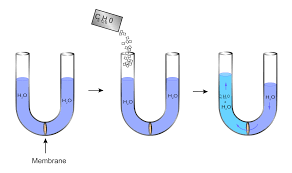Osmotic Pressure Formula
Osmotic pressure and its concept are very important in chemistry mainly in physical chemistry. If two solutions of having different concentrations and are separated by a semipermeable membrane, then an interesting osmosis process will happen. The solution having lower concentration will pass the water through the membrane towards the solution with the higher concentration. This article will explain osmosis and Osmotic pressure formula with examples. Let us begin it!

Source: en.wikipedia.org
Osmotic Pressure Formula
What is Osmosis?
One can define the Osmotic pressure as the minimum pressure which is needed for a solution to halt the flow of solvent molecules through a semipermeable membrane. Osmosis process refers to the movement of solvent molecules through a membrane from a segment with low concentration is low to the segment with the high concentration. Eventually, this process maintains an equilibrium between the two sides of the semipermeable membrane.
The semipermeable membrane is a specific kind of membrane, which allows the movement of solvent molecules through it, but solute particles cannot pass through it. If we apply sufficient pressure to the solution side of the semipermeable membrane, this process of osmosis will halt.
Here, the minimum amount of pressure for nullifying the process of osmosis is termed as the osmotic pressure. This process will continue until the situation when the concentrations of the two solutions become the same. It may also happen if the added pressure becomes too great for any more water to pass through the membrane.
The formula for Osmotic Pressure
We can determine the Osmotic pressure with the help of the following formula:
Where,
| The osmotic pressure. | |
| i | The van’t Hoff factor. |
| C | The molar concentration of the solute in the given solution. |
| R | The universal gas constant. |
| T | The temperature on the Kelvin scale. |
Dutch chemist Jacobus van’t Hoff gave this relationship between the osmotic pressure of a solution and the molar concentration of its solute. However, this equation holds for the solutions that behave like ideal solutions.
Some Applications
Plants maintain their upright and straight shape with the help of osmotic pressure. The measurement of osmotic pressure is useful to determine the molecular weights of compounds. Another common but important application of osmotic pressure is in the desalination and purification of seawater using the process of reverse osmosis.
Solved Examples
Q.1: One mole of table salt is dissolved into water of volume of one liter. At a temperature of
Solution:
The molar concentration of table salt i.e. sodium chloride in the solution is 1mol per 1litre.
So, C = 1 M
Since NaCl dissociates into two ions. So, the value of the van’t Hoff factor will be 2.
i.e. i = 2.
Temperature, T =
Universal Gas Constant, R will be 0.0821 atm L
Now, we can apply the formula for osmotic pressure as:
Substituting the known values in the above equation we will have,
Thus, the osmotic pressure of the 1 M salt solution will be 49.26 atmospheres at a temperature of